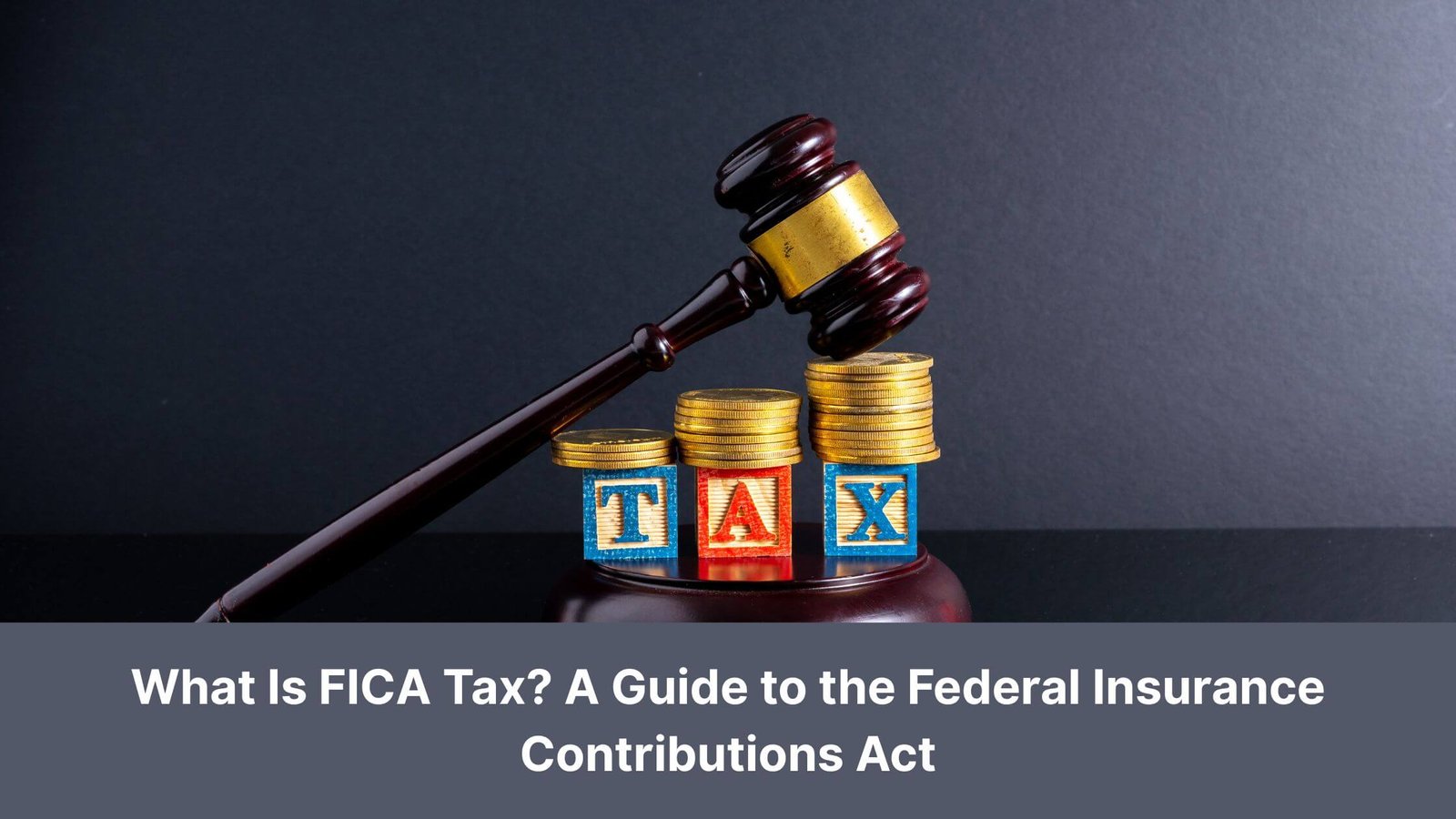Whether you receive the paycheck or paystub, you will notice a specific part of your salary is deducted, labeled as FICA, and you may wonder why this FICA is taken out of your earnings.
The Federal Insurance Contributions Act, better known as FICA, is crucial in funding two of the most special federal programs in the United States: Social Security and Medicare.
These programs will provide millions of Americans with income and health benefits. They will help retirees, people with disabilities, and survivors of decreased workers.
You will learn how much you pay, why you pay it, and who is exempt. By the end, you will understand the FICA, but also how it fits into the bigger picture of financial security in America. Now let us dive in.
1. What Is FICA?
The Federal Insurance Contribution Act, shortened as FICA, is a US federal law that imposes payroll taxes to fund programs for old age, survivors, social security, hospital insurance, and Medicare for the elderly.
Whether you are a full-time employee, a freelancer, an independent contractor, a small business owner, or self-employed, you have to understand FICA and learn how it works. FICA is easy to understand and simple, using accurate details from verified government portals such as the IRS and the Social Security Administration.
Every time you get paid, your in-hand salary automatically gets deducted to pay these taxes, with your employer matching your contributions pany by pany. Together, this will contribute to the backbone of two major safety-net programs in America, Social Security and Medicare.
2. A Short History of FICA
If you wonder why FICA was created and what the history behind FICA is, here are a few glimpses of the history that make you understand the history behind FICA’s creation
In the pre-1930 era, you will not find a single system that supports disabled Americans; most Americans have to rely on their saving in case they lose a family breadwinner. In case the employees get injured or are too old to work for a living, then the income generation is stopped, and they only have to rely on their family to support them, or need charity to survive.
During the Great Depression, millions of employees faced mass layoffs, which led President Franklin D. Roosevelt‘s administration to implement another tax that would protect vulnerable citizens and rebuild the broken economy.
3. How Would This System Be Paid For?
If you wonder how this FICA system works, the Federal Insurance Contributions Act was enacted as part of the same 1935 legislation that established a payroll tax. That means that tax gets deducted from the employee’s gross salary, which funds the social security program. Organizations or employers also have to match the payments.
In the year of 1960, somewhere in the middle of the year, health care expenses became a serious issue for senior citizens. Many senior citizens could not afford hospital care or even health insurance.
To solve this issue, President Lyndon B. Johnson signed Medicare into federal law in 1965. This new program, an increase in FICA deductions, will ensure that senior citizens will receive hospital care regardless of poverty.
As of now, FICA funds both Social Security and Medicare, and it has become the core of the American financial safety net, providing monthly income and medical coverage to retirees, disabled people, and the families of deceased workers.
In short, FICA was much more than just a simple tax; it is a social contract intended to ensure that employees will receive relief after a lifetime of service and will not be left without assistance in their old age and during challenging situations.
4. How Much FICA Do You Pay?
Let’s discuss Employee and Employer Shares in depth, according to IRS Topic 751, the current rates are:
- Social Security: 6.2% of wages paid by both employee and employer (12.4% total)
- Medicare: 1.45% by each (2.9% total)
There’s also an Additional Medicare Tax of 0.9% on earnings above certain thresholds, which is only paid by the employee.
Wage-Based Limit
Social Security taxes only apply up to a wage cap, which adjusts annually. For 2025, that limit is $176,100. Earnings above this cap are not subject to Social Security tax, but Medicare taxes continue with no limit.
Self‑Employed (SECA Tax)
Self-employed individuals pay both the employee and employer portion under SECA. That adds up to:
- 12.4% Social Security
- 2.9% Medicare
However, you’re allowed to deduct the “employer” half when filing taxes.
5. What Income Counts for FICA?
FICA applies to gross salary, which includes gross wages, bonuses, and tips, some retirement plan contributions, and total net wages from self-employment and wages from household employees earning over a set threshold. FICA taxes do not apply to any investment income, such as interest, dividends, and capital gains earnings.
6. Additional Medicare Tax Details
Since 2013, people who earn some income limits have met an extra 0.9% Medicare tax, which only applies to revenues above the threshold, there is no matching employer’s ownership interest, and it should be stopped by employers from the payment period. When the income is more than the threshold, the rest continues.
Consumers who serve in many jobs or are self-employed may be more likely to stop and may claim to submit Form 8959 and make estimated tax payments.
7. Employer Responsibilities
As per US federal law, employers are legally accountable to manage the payroll and report taxes correctly, including FICA and other implied taxes. In short, employer have a legal obligation to handle both their shares, including social security and medicare taxes, accurately and on time. Here is what that includes:
Employee FICA Taxes
Employers should cut the right amount of social security (6.2%) and Medicare (1.45%) taxes from each employee’s salary. If an employee serves more than a certain limit, the employer will also have to stop the extra Medicare tax in addition to the 0.9% salary tax on that amount. This tax only applies to employee shares.
Match the Contributions
Employers should match the employee’s social security and Medicare taxes by paying the same amount from their funds: 6.2% for social security and 1.45% for Medicare. This means that for most employees, the total FCA contribution is 15.3%, with half of the payment from the employer.
Deposit Payroll Taxes
When these amounts are calculated, employers must deposit taxes monthly or semiweekly with the IRS, depending on the size of the payroll. In order to avoid late fees or penalties, deposits should be made electronically using the Electronic Federal Tax Payment System (EFTPS).
File Payroll Tax Forms
Employers must also submit a tax return to report what was done and paid:
- Form 941: A quarterly form submitted by most employers to report tax for income tax, social security, and Medicare.
- Form 944: Eligible for annual reporting is submitted by small employers each year.
- Form 943/945: Used for specific types of employers (such as agricultural work or backup).
Timely and accurate archiving is necessary to remain in line with federal tax law.
Report on Employee W-2 Forms
Employers must provide each employee with a form W-2 at the end of each year, which shows the total income, FICA tax, and other deductions. Copies are also submitted to the Social Security Administration (SSA) to help the employees’ income history and future benefits qualify.
Ensure Compliance
Although an employee fails to inform the employer of their total income (for example, if they have more jobs), the employer is still legally responsible for withholding and paying the correct FCA taxes based on the salary paid to them. The IRS justifies that employers pay their share, regardless of whether the total income of the employee triggers extra medical fees.
Avoid Penalties and Interest
If an employer fails to control, submit, or report FICA taxes properly, the IRS may apply severe penalties, interest fees, and, in some cases, even legal action. This includes the Penalty Fund’s recovery penalty (TFRP), which individually contains responsible individuals for unpaid taxes.
8. Refunds & Corrections
Sometimes, FICA taxes are paid in error or due to supervision. In such cases, the IRS allows reimbursement or improvement, but the process varies depending on the type of employment and visa status.
If you’re an employee and believe FICA was wrongly withheld from your paycheck:
Step 1: Contact your employer first
The IRS recommends contacting your employer directly. In most cases, employers can issue reimbursement by adjusting the wage records and correcting the tax authorities.
Step 2: File IRS form 843 (and form 8316 if used)
If your employer cannot refuse to return tax by stopping errors, you may claim form 843: Refund and Request for Abatement with the IRS.
If you are a non-permanent foreigner (eg, F-1, J-1,1, or M-1 visa holder), you must also enter form 8316 to document your visa status and prove your exemption.
You’ll need to attach:
- A copy of your Form W-2.
- Passport pages showing your visa.
- Your Form I-94.
- Form I-538 (if applicable).
- A signed employer’s declaration (or if your employer is not cooperating).
You can find these forms and instructions on the IRS website.
For self-employed
If you are self-employed and find that you have reduced SECA tax (self-employed version of FCA), you must correct it through it:
There is no separate “refund” process like W-2 employees, but if you overpaid, you can adjust it on your annual return.
9. Why FICA Is Important
FICA is not just a line element at Paychex; It is a fundamental part of the US social security net. Taxes collected through FICA support the necessary programs that benefit millions of Americans, including retired persons, disabled people, family members of deceased workers, and pensioners.
Let’s see why your FCA contribution is.
Supports Vital Programs
FICA directly funds two major federal programs: Social Security and Medicare.
Social Security provides:
- Pension benefits are for workers who have paid into the system during their careers.
- Disability insurance for people who cannot work due to a medical condition.
- Survival benefits for children of deceased husbands from countries and deceased workers.
Medicare offers:
Hospital insurance (Part A) is available to people 65 years of age and older or younger people with disabilities.
This ensures that millions of us can get hospital care without going into financial difficulties.
Without FICA, these programs wouldn’t exist. Your regular paycheck deductions help fund basic living and healthcare needs for those who rely on them most.
Builds This Generation’s Benefits
FICA is not just about supporting others; it also builds your future benefits.
- When you work and pay FICA taxes, the Social Security Administration tracks your income history using your Social Security Number (SSN). Based on this post, you earn “credit” against future eligibility for profits.
- You can earn up to 4 credits per year, and most need 40 credits (equivalent to 10 years of work) to qualify for a pension.
- Benefits for Social Security.
- The more you earn (to the annual degree), the greater your possible monthly gain in retirement.
Therefore, even though FICA does not go to a personal savings account, it protects your future as a pension, disability, or survivor’s payment.
Intergenerational Support
One of the most unique aspects of FICA is how it operates on a pay-as-you-go system. This means:
Today’s workers pay FICA taxes that fund benefits for today’s retirees and other beneficiaries.
In other words, the money you contribute now isn’t held in a private fund for your personal use. Instead, it’s used to support the current generation in need.
Social Security
This structure helps maintain the social security and stability of Medicare programs from one generation to another.
Any additional revenue that is not used immediately for profits goes to the Social Security Trust Fund, managed by the US Treasury. These trust funds help protect and expand the availability of future benefits by investing in interest-bearing securities.
10. Financial Outlook & Potential Changes
The Social Security and Medicare trust funds face projected shortfalls:
The Social Security OASDI fund may be depleted by 2033, requiring 21% benefit cuts unless corrected.
Medicare Hospital Insurance may run short by 2036.
Policy options include:
- Salary-based or tax rates
- Rise: The age of retirement
- Using general tax revenues
- Adjusting benefits
All require action from Congress.
11. What You Can Do Now
For Workers:
- Check pay stubs: Verify FICA withholding.
- Review your SSA account: Track contributions and future benefits.
- Account for extra Medicare tax: If you earn above the thresholds.
For Self-Employed:
- File Schedule SE and deduct half of your SECA tax.
- Make quarterly tax payments to avoid penalties.
For Employers:
- Use the current Publication 15 & 15-A for withholding rules.
- Enter the exact wage treatment to keep you obedient.
- File on time to avoid punishment.
- File payroll taxes timely to avoid penalties.
For Nonresidents or Students:
- Understand exemptions using totalization agreements or student rules
- Document for exemption (eg, Visa stamp, I-94)
12. Why It All Matters
- FICA funds the nation’s bedrock safety nets: retiree pensions, disability, and hospital coverage
- Your payments today build tomorrow’s security, for you and others.
- Staying informed makes sure you’re contributing correctly and receiving the full benefits you’ve earned.
Key takeaways
FICA may seem like just another tax, but in reality, it’s the backbone of America’s social insurance system. It protects millions of families from poverty due to aging, disability, or the death of a loved one. And for working Americans, it serves as a promise that after years of contribution, financial help will be there when they need it most.
How does StubCreator help?
FICA isn’t just a paycheck reduction; it’s your contribution to national social insurance and your future. Understanding the rates, rules, and outlook helps you plan wisely and ensure you’re paying and protected correctly.
Ready for Easy, Accurate Payroll?
If you’re starting a business, managing payroll, or generating paychecks for others, StubCreator offers an easy, reliable solution. Get professional, tax-compliant pay stubs, complete with accurate FICA and payroll calculations. Try StubCreator’s payroll check generator today and simplify your payroll while staying confident in your tax compliance!
FAQ's
What is FICA tax?
+
FICA (Federal Insurance Contributions Act) tax is a payroll tax that funds Social Security and Medicare programs. It is deducted from employees' wages and matched by employers.
Who pays FICA tax?
+
Both employees and employers contribute to FICA tax. Employees pay a portion of the tax through payroll deductions, and employers match the amount.
How much is the FICA tax rate?
+
The FICA tax rate is 7.65% for employees: 6.2% for Social Security and 1.45% for Medicare. Employers also contribute 7.65%, matching the employee's contribution.
Is FICA tax the same as income tax?
+
No, FICA tax is separate from income tax. While income tax is based on your earnings and supports general government expenses, FICA tax specifically funds Social Security and Medicare.






